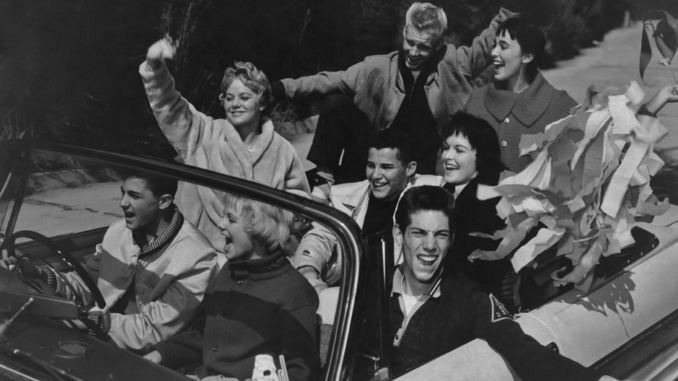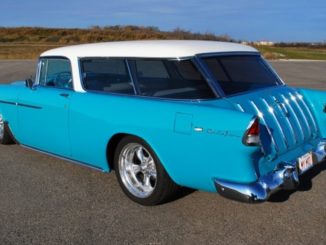
For nearly a century, coming of age in America meant getting behind the wheel. A driver’s license marked the transition from childhood and dependence to adult responsibility and freedom.
To many, it was a far more important milestone than voting or legal drinking. It was the beginning of a new world—of cruising down Main Street to meet with friends and compete with rivals; the ritual of being picked up for a date and making out while “parking”; and of the pleasures and frustrations of repairing, souping up, customizing, or racing a car.
Something is missing in the lives of today’s adolescents: that magical coming-of-age feeling when a whole world opened up.
This world, familiar to anyone who has seen American Graffiti, the 1973 paean to teen driving, was unique to the U.S. No teens in any other country in the world shared American teens’ level of enthusiasm for all things automotive. This was in part because in the mid-20th century there was a wealth of available cars—cheap used ones from the late 1920s—as well as the fact that by 1940, American teenagers were more likely to be attending high school than working. Elsewhere, 16-year-olds rode bikes or buses and had jobs.
Practically nowhere else on earth did teens have the means—and, as high-school students and not full-time workers, the time—to join the adult world of automobility. And they did so on their own terms, partially emulating their elders who had cars, but also by using cars to craft their own personal styles and escape their parents’ control.
Some young car enthusiasts remain today, but American teens have as a whole moved on. According to the Federal Highway Administration, the percentage of American 16-year-olds with driver’s licenses was roughly 25 percent in 2014, a steep drop from about 46 percent in 1983.
Older Americans who gather at old hot-rod and antique car shows lament how their offspring show no interest in their hobby, and car makers and dealers fret over how to sell to an increasingly elusive teen market. What’s changed? The answers are technological, legal, and cultural.
One thing is clear: It is harder to get a car these days. Thanks to technological advances, the cars of the last few decades are better made and last longer—and thus cost more, even when they’re used.
And the old strategy of buying a “junker,” a car in bad shape, and then replacing a faulty alternator with a cheap scrap-yard part is practically impossible to do on one’s own; repairs in the digital age require more skill and equipment than most teens have.
And rising costs meant that poorer teens—especially African American and Hispanic teens—have been more likely to do without. A half-dozen years ago, about a quarter of 16-to-18-year-olds from households earning less than $20,000 per year had driver’s licenses, compared to the three-quarters of their counterparts in households earning over $100,000 who had licenses.
Vehicles aside, getting a license in the first place is harder than it used to be. Once, it was a rite of passage to turn 16 and become a full-fledged driver. But since the 1970s, psychologists, safety officials, and legal scholars have campaigned to raise the age requirement to 17 or 18, with more limited permits provided for younger ages.
They’ve argued that younger age requirements are a holdover from a time when America was more rural and families needed their teen children, sometimes as young as 14, to drive vehicles on the family farm.
These experts amassed great troves of data showing that 16-year-olds, especially boys, lacked the maturity to drive powerful machines on the public road, noting that 16- and- 17-year-olds were responsible for far more crashes than were even their 18- or 19-year-old counterparts.
By the mid-1990s, most states were adopting the so-called Graduated Driver’s License, a multi-step licensing process for young drivers that includes complicated rules about when and where 16-year-olds can drive.
The requirement of adult-supervised behind-the-wheel training, prohibitions against night driving, and special penalties for infractions, as well as the rising costs of driver-education classes (which have been dropped from some high-school curricula in recent years) have all led many young people to delay learning to drive until they turned 18 and were free of these restrictions. This new legal regime brings America more in line with many other industrial nations, where the age of 18 has long been the norm.
But the decline of teen driving over the past few decades has roots beyond the practicalities of getting a car and a license: Local authorities have also become less willing to allow teens to play around with cars. By the 1980s, many politicians and local businesses demanded that police across the country restrict and ultimately ban the rites of “cruising” (driving around aimlessly) and “parking” (making out in parked cars).
Cruising was considered a nuisance because it could interfere with people going about their daily errands and commutes. This inconvenience was tolerated for some time, but by the late 1970s, some local authorities and businesses were voicing concerns about an invasion of outsiders (often nonwhite ones) from different neighborhoods—in part a product of the expansion of freeway systems in areas such as suburban Los Angeles.
Complaints like these prompted cruising bans across the country.While cars themselves are losing their place in teen culture, the freedoms and pleasures that they once brought to young people now often seem to be won through other means. The smartphone is the most obvious replacement, offering a virtual liberation from the constraints of family that the car once provided physically. Additionally, with more parents—particularly more moms—away from home during the day, many teens can find privacy right in their own living rooms and bedrooms, with no need for a car to take them elsewhere or provide its own sanctuary.
Though these changes mean that teens still find the freedom and privacy that cars once afforded, one thing is gone: that magical age of 16, when suddenly a world opened up. Many teens have been using smartphones since they were kids; privacy in their homes has been granted to them gradually over time. The rite of passage is gone, along with the excitement and anticipation that preceded it for so many.
This post originally appeared on The Atlantic.
About the Author: Gary Cross is an emeritus professor of history at Penn State and the author of Machines of Youth: America’s Car Obsession.




